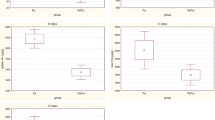Abstract
A series of nine experiments were done to obtain further evidence that boron might be involved in major mineral metabolism (Ca, P, and Mg), thus indicating that boron is an essential nutrient for animals. Eight factorially arranged experiments of 6–10 wk durations were done with weanling Sprague-Dawley male rats. One factorially arranged experiment was done with weanling spontaneously hypertensive rats. The variables in each experiment were dietary boron supplements of 0 and 3 μg/g, and dietary magnesium supplements of either 200 (Experiments 1–3) or 100 (Experiments 4–9) and 400 μg/g. In Experiments 7 and 9, a third variable was dietary manganese supplements of 25 and 50 μg/g. Methionine status was varied throughout the series of experiments by supplementing the casein-based diet with methionine and arginine. Findings were obtained indicating that the severity of magnesium deprivation and the methionine status of the rat strongly influence the extent and nature of the interaction between magnesium and boron, and the response to boron deprivation. When magnesium deprivation was severe enough to cause typical signs of deficiency, a significant interaction between boron and magnesium was found. Generally, the interaction was characterized by the deprivation of one of the elements making the deficiency signs of the other more marked. The interaction was most evident when the diet was not supplemented with methionine and especially when the diet contained luxuriant arginine. Signs of boron deprivation were also more marked and consistent when the diet contained marginal methionine and luxuriant arginine. Among the signs of boron deprivation exhibited by rats fed marginal methionine were depressed growth and bone magnesium concentration, and elevated spleen wt/body wt and kidney wt/body wt ratios. Because the boron supplement of 3 μg/g did not make the dietary intake of this element unusual, it seems likely that the response of the rats to dietary boron in the present study were manifestations of physiological, not pharmacological, actions, and support the hypothesis that boron is an essential nutrient for the rat.
Similar content being viewed by others
References
E. Hove, C. A. Elvehjem, and E. B. Hart,Am. J. Physiol. 127, 689 (1939).
E. Orent-Keiles,Proc. Soc. Exp. Biol. Med. 44, 199 (1941).
J. D. Teresi, E. Hove, C. A. Elvehjem, and E. B. Hart,Am. J. Physiol. 140, 513 (1944).
J. T. Skinner and J. S. McHargue,Am. J. Physiol. 143, 385 (1945).
R. H. Follis, Jr.,Am. J. Physiol. 150, 520 (1947).
C. D. Hunt and F. H. Nielsen,Trace Element Metabolism in Man and Animals, vol. 4, J. McC. Howell, J. M. Gawthorne, and C. L. White, eds., Australian Academy of Science, Canberra, 1981, pp. 597–600.
C. D. Hunt, T. R. Shuler, and F. H. Nielsen,Spurenelement Symposium, M. Anke, W. Baumann, H. E. Braunlich, and C. Bruckner, eds., Karl Marx Universitat Leipzig and Friedrich Schiller Universitat, Jena, GDR, 1983, pp. 149–155.
M. E. Shils,Trace Elements in Human Health and Disease, vol. II, A. S. Prasad and D. Oberleas, eds., Academic, New York, NY, 1976 pp. 23–46.
A. Berthelot and J. Esposito,J. Amer. Coll. Nutr. 4, 343 (1983).
F. H. Nielsen and B. Bailey,Lab. Anim. Sci. 29, 502 (1979).
F. H. Nielsen, D. R. Myron, S. H. Givand, and D. A. Ollerich,J. Nutr. 105, 1607 (1975).
F. H. Nielsen, D. R. Myron, S. H. Givand, T. J. Zimmerman, and D. A. Ollerich,J. Nutr. 105, 1620 (1975).
B. N. Wu, D. M. Medeiros, K.-N. Lin, and B. M. Thorne,Nutr. Res. 4, 305 (1984).
H. Scheffé,The Analysis of Variance, Wiley New York, NY, 1959, pp. 90–137.
K. Keshavarz and H. L. Fuller,J. Nutr. 101, 217 (1971).
J. A. Sturman,Sulfur Amino Acids Biochemical and Clinical Aspects, Progress in Clinical and Biological Research, vol. 125, K. Kuriyama, R. J. Huxtable and H. Iwata, eds., Liss Inc., New York, NY, 1983, pp. 281–295.
B. L. Robeson, T. L. Maddox, and W. G. Martin,J. Nutr. 109, 1383 (1979).
M. H. Stipanuk,Ann. Rev. Nutr. 6, 179 (1986).
M. Bara and A. Guiet-Bara,Magnesium 3, 212 (1984).
J. F. Jackson and K. S. R. Chapman,Trace Elements in Soil-Plant-Animal Systems, D. J. D. Nicholas and A. R. Egan, Eds., Academic, New York, NY, 1975, pp. 213–225.
D. H. Lewis,New Phytol. 84, 209 (1980).
A. S. Pollard, A. S. Parr, and B. C. Loughman,J. Exp. Bot. 28, 831 (1977).
E. Haberman,Naunyn-Schmiedeberg’s Arch. Pharmacol. 323, 269 (1983).
T. S. S. Chen, C.-J. Chang, and H. G. Floss,J. Antibiotics 33, 1316 (1980).
A. J. Parr and B. C. Loughman,Annu. Proc. Phytochem. Soc. Eur. 21, 87 (1983).
D. J. Pilbeam and E. A. Kirkby,J. Plant Nutrition 6, 563 (1983).
W. M. Duggar,Encyl. Plant Physiol., New Ser. 15B, 626 (1983).
T. Tanada,J. Plant Nutr. 6, 743 (1983).
F. H. Nielsen,J. Nutr. 115, 1239 (1985).
M. Nuurtamo, P. Varo, E. Saari, and P. Koivistoinen,Acta Agric. Scand. Suppl.22, 57–76, 77–87 (1980).
P. Varo and P. Koivistoinen,Acta Agric. Scand. Suppl.22, 165 (1980).
P. Varo, M. Nuurtamo, E. Saari and P. Koivistoinen,Acta Agric. Scand. Suppl.22, 27–35, 37–55, 89–113, 115–126, 127–139, 141–160 (1980).
A. K. Furr, L. H. MacDaniels, L. E. St. John Jr., W. H. Gutenmann, I. S. Pakkala, and D. J. Lisk,Bull. Environ. Contam. Toxicol. 21, 392 (1979).
A. K. Furr, T. F. Parkinson, C. A. Bache, W. H. Gutenmann, I. S. Pakkala, G. S. Stoewsand, and D. J. Lisk,Nutr. Rpts. Int. 20, 765 (1979).
J. Ploquin,Bull. Soc. Sci. Hyg. Alimen. 55, 70 (1967).
A. S. Szabo,Lebensmittelindustrie 26, 549 (1979).
Author information
Authors and Affiliations
Additional information
Mentions of a trademark or proprietary product does not consitute a guarantee or warranty of the product by the US Department of Agriculture and does not imply its approval to the exclusion of other products that may also be suitable.
Rights and permissions
About this article
Cite this article
Nielsen, F.H., Shuler, T.R., Zimmerman, T.J. et al. Magnesium and methionine deprivation affect the response of rats to boron deprivation. Biol Trace Elem Res 17, 91–107 (1988). https://doi.org/10.1007/BF02795449
Received:
Accepted:
Issue Date:
DOI: https://doi.org/10.1007/BF02795449




